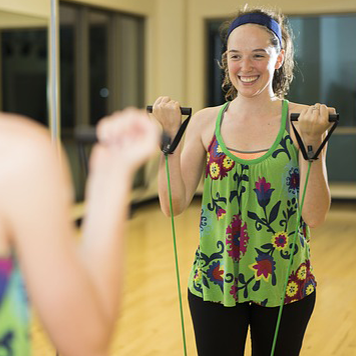Muscle Soreness: Myths vs. Facts

"No pain, no gain."
"Lactic acid build-up."
"An indicator of muscle growth."
These are all phrases that we tend to associate with delayed onset muscle soreness (DOMS). While you may think you know everything you need to know about the condition that has you waddling like a duck, you may be surprised by what's actually happening in your body.
Myth #1: DOMS is caused by the build-up of lactic acid in your muscles.
Verdict: Not true.
During exercise, your body needs energy, and it breaks down molecules to get that energy. As a result of this metabolic process, your cells naturally become more acidic, which makes your muscles feel like they're burning. But this isn't caused by lactate. Lactate is actually a by-product of the metabolic process and serves as a buffer that slows down the rate at which the cells become acidic. Humans produce lactate all the time, even at rest. It clears from the system 30 minutes to one hour after working out.
A study in Clinics in Sports Medicine found that DOMS is the result of microtrauma in the muscles and surrounding connective tissues, which causes inflammation. Eccentric muscle contractions, such as lowering a dumbbell down after a bicep curl, are more likely to be a culprit of this inflammation. That motion places a higher load on your muscles compared to concentric muscle contraction, such as lifting a dumbbell during a bicep curl. Think of it this way: it is the active lengthening of muscle fibers under load. It's like you're pulling on a rope, and there's so much force that the rope starts to tear and pull apart.
Myth #2: It's not a good workout unless you're sore the next day.
Verdict: Not true.
We fitness fanatics often wear our DOMS as a badge of honor and believe that if we're not sore, we're not doing enough during out workouts. But that's just not true.
"It doesn't mean that you're not getting as good of a workout because you're not crippled the next day," says Monica Vazquez, a National Academy of Sports Medicine-certified personal trainer. "You should feel soreness 24 hours to three days after the activity. If, after three days, you try to do the same exercise and you cannot because you go immediately to muscle failure, you've done too much," she says.
Studies have shown that soreness itself (using a scale from 0 to 10 to assess the level of soreness) is a poor indicator of muscle adaptation and growth-there are many factors that influence how DOMS presents itself in individuals.
Myth #3: The more fit you are, the less susceptible you are to DOMS.
Verdict: True, with modifications.
It's true that you will start to feel less sore as your body adapts to your workouts and learns to distribute the workload across your muscle fibers more effectively. That's why you should regularly change up your exercise routine.
However, there is also a genetic component to how sensitive we are to pain and soreness. People can be no-responders, low-responders or high-responders to soreness. If you're a high-responder, you will experience DOMS more acutely than someone who is a no- or low-responder when given the same training load.
While you can't change your genes, it is important to know where you fall on the spectrum to understand how your body may respond to changes in your workouts.
Myth #4: Muscle damage is a bad thing.
Verdict: Not always.
Yes, DOMS appears to be caused by trauma to your muscle fibers, but it's not a definitive measure of muscle damage. In fact, a certain degree of soreness seems to be necessary when building muscle mass. When muscles repair themselves, they get larger and stronger than before so that muscle soreness doesn't happen again. While these mechanisms are not completely understood, some muscle trauma is needed to stimulate protein production and muscle growth.
Myth #5: Pre- and post-workout stretching is a good way to prevent and treat DOMS.
Verdict: Unfortunately, no.
A review of studies for the Cochrane Database of Systematic Reviews on the effects of stretching before or after exercise on the development of DOMS found that pre- and post-workout stretching did not reduce the effects of DOMS in healthy adults. In fact, research has found that static stretching prior to working out does not safeguard you against injury and may actually decrease your power and strength.
While you may not be able to avoid soreness altogether, the American College of Sports Medicine suggests advancing slowly with a new workout, giving your muscles time to adapt and recover. It is best to warm-up properly with dynamic stretching and light cardiovascular work, and always include a cool down period.